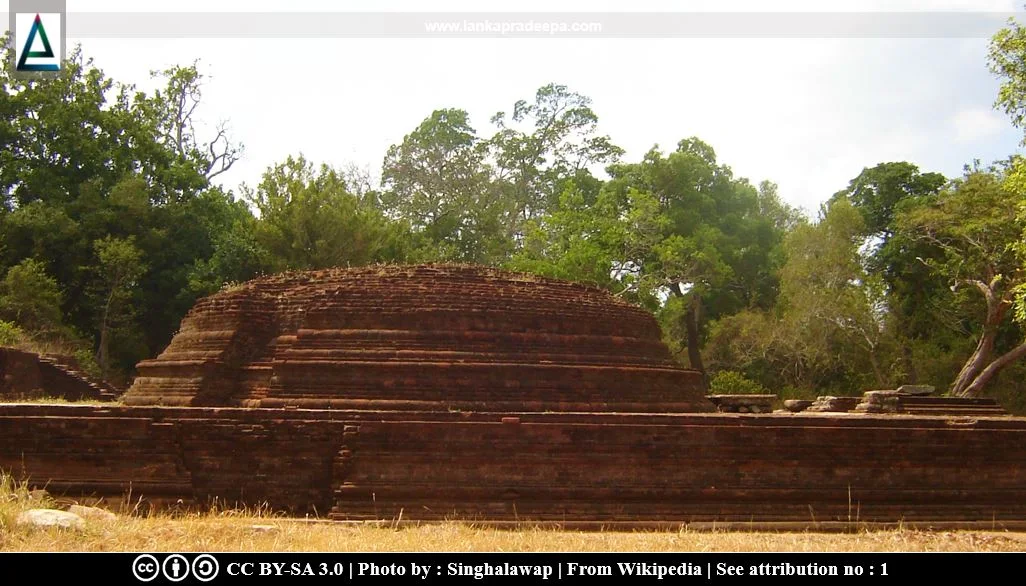
Velgam Vehera (Sinhala: වෙල්ගම් වෙහෙර) is a ruined Buddhist temple situated near Mahawewa (Tamil: Periyakulam) in Trincomalee District, Sri Lanka. Known among the local Hindus as Natanar Kovil, this temple is said to be the only example of a Tamil Vihara or Buddhist Palli in the country (Nicholas, 1963; Ray, 1960).
History
This temple was founded by Sinhalese Buddhists before the 2nd century A.D. (Ray, 1960). In an inscription of King Bhatikatissa (143-167 A.D.), which is found engraved on the adjoining hill, this temple is called Abagara Vihara at Velagama (Nicholas, 1963). A fragmentary slab inscription of King Udaya IV (946-954 A.D.) was discovered at this site in 1953 (Ranawella, 2004).
Cola Period
During the Cola occupation of Anuradhapura from 993 to 1070, this site received the patronage and protection of Cola Tamils who were predominantly Hindus (Pathmanathan, 1978). Although they are said to have destroyed the other Buddhist temples in the country, their treatment for this temple was different (Ray, 1960). They made donations, renovated its buildings, and renamed it after their king, Rajarajaperumpalli (Nicholas, 1963; Pathmanathan, 1978; Ray, 1960). More than 15 Tamil inscriptions that have been recovered from the site reveal some information regarding the donations made to this temple during the reigns of Cola kings such as Rajaraja I (c. 985-1014 A.D.) and Rajendradeva [(1054-1063 A.D.) Pathmanathan, 1978; Ray, 1960].
Transcript I: (1) Sri ... la (2) r annal mancan (3) Mummuticolamantala- (4) ttu melaitturu ...>>
Translation I: 5 oxen and 35 cows were endowed for merit to Lord Buddha of Saddha Vihara known as Velgam Vihara alias Rajarajapperumpalli of Pancacantulagama of Melaitturu Sriyantan Parakecari valanatu in Mummuticolamantalam.
Transcript II: (1) Sri pakavan putukku- (2) tiyan Atittapp- (3) peraraiyan stavayca- (4) ram ...>>
Translation II: Worship to Lord Buddha, Atittaperaraiyam, an inhabitant of Putukkutti, granted 84 cows for a perpetual lamp to Rajarajapperumpalli alias Velkam Vihara, situated in Stavayia Ramyana Manavatina nattu.
Citation: Dias, 1990. p.159.
After the end of the Cola Period, the site was again occupied by the Sinhalese Buddhists (Nicholas, 1963; Ray, 1960). King Vijayabahu I (1055-1110 A.D.) who expelled Colas from the country restored several Buddhist temples including the Velgam Vehera (Ray, 1960). Sinhalese inscriptions dated in the reign of this king have been unearthed from the site (Ray, 1960). As recorded in the Priti-Danaka-Mandapa Rock Inscription at Polonnaruwa, King Nissankamalla (1187-1196 A.D.) visited this site (Nicholas, 1963; Ray, 1960; Wickremasinghe, 1928).
Velgam Vehera Sinhala slab inscription
Period: 11th century A.D. Reign: Vijayabahu I (1055-1110 A.D.)
Language & Script: Medieval Sinhalese
Transcript: (1) Svasti Sri Sirisangabo Sri Vi- (2) ja(yabahu ma)harajanan va (3) (n seta) ... vanne a (se)- ...>>
Translation: (Success) On Monday the ... of the (month) of Asala during the year of His Majesty Sri Sangabo Sri Vijayabahu, I. a royal merchant of Alagiya named (Kalpakara bahu)(sapahini)nayangan Kit, donate, 3 tiered bronze lamp (perpetual) in the name of the Lord Buddha at Velgam Vehera. Ten...>>
Notes: This is one of the Sinhalese inscriptions set up at Velgam Vehera, after the restoration of Sinhalese sovereignty after the Colas.
References: Dias, 1991. p.60.; Ranawella, 2007. p.12.
Statues and structures
Velgam Vehera standing Buddha
This statue of Buddha carved out of dolomite limestone, is 2.1 m tall and standing on a lotus pedestal. The right hand of it shows Abhaya-mudra and the bent left hand, which is now destroyed, possibly was holding the robe that falling over the forearm. The robe firmly touches the body and its pleats are slightly visible.
Scholars have dated this statue to the 7th-8th century A.D. (Chutiwongs et al., 2007). However, it evidently displays the classical qualities of the Gupta standing Buddha of Mathura of the 5th century (Chutiwongs et al., 2007).
The image house
The remains of the image house reveal that it was a 56 ft. long 28 ft. 7 in. wide edifice in its fully developed stage (Ray, 1960). The base of it contains characteristic Dravidian mouldings (Ray, 1960).
Archaeological Museum
A small site museum of the Archaeological Department is situated on the
premises of Velgam Vehera Viharaya. The museum is used to exhibit antiquities
recovered from the temple.
Attribution
1) වෙල්ගම්වෙහෙර දාගැබ and වෙල්ගම්වෙහෙර හිටි බුදුපිලිමය by Singhalawap are licensed under CC BY-SA 3.0
References
1) Chutiwongs, N.; Prematilleke, L.; Silva, R., 2007. Sri Lanka Murthi: Buddha (Sri Lanka Sculpture: Buddha). Central Cultural Fund. Ministry of Cultural Affairs. pp.56-57.
2) Dias, M., 1990. Inscriptions 800-1200 A.D. [Wijesekara, N. (Editor in chief)]. Archaeological Department centenary (1890-1990): Commemorative series: Volume II: Inscriptions. Department of Archaeology (Sri Lanka). p.159.
3) Dias, M., 1991. Epigraphical notes (Nos 1 -18). Colombo: Department of Archaeology. pp.59-60.
4) Nicholas, C. W., 1963. Historical topography of ancient and medieval Ceylon. Journal of the Ceylon Branch of the Royal Asiatic Society, New Series (Vol VI). Special Number: Colombo. Royal Asiatic Society (Ceylon Branch). p.45.
5) Pathmanathan, S., 1978. The Kingdom of Jaffna; Part I. pp.59-60.
6) Ranawella, G.S., 2004. Inscription of Ceylon. Volume V, Part II. Department of Archaeology. pp.209-210.
7) Ranawella, S., 2007. Inscription of Ceylon. Volume VI. Department of Archaeology. ISBN: 978-955-91-59-61-2. p.12.
8) Ray, H. C. (Editor in Chief), 1960. University of Ceylon: History of Ceylon (Vol 1, part II). Ceylon University Press. pp.415,430,434-435,511,590.
9) Wickremasinghe, D. M. D. Z., 1928. Epigraphia Zeylanica: Being lithic and other inscriptions of Ceylon (Vol, II). Published for the government of Ceylon by Humphrey Milford. p.177.
Location Map
This page was last updated on 2 July 2023



